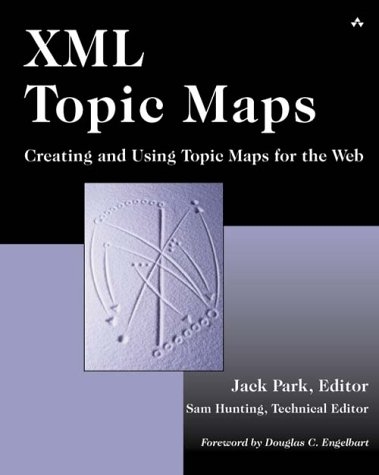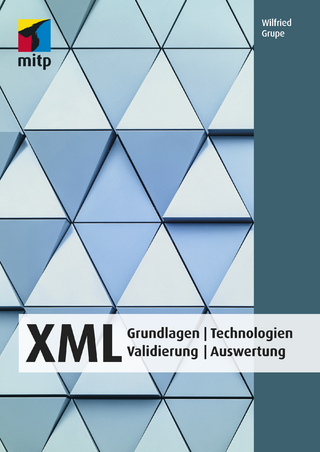
XML Topic Maps
Addison Wesley (Verlag)
978-0-201-74960-1 (ISBN)
- Titel ist leider vergriffen;
keine Neuauflage - Artikel merken
XML Topic Maps (XTM) represent a powerful new tool for transforming the Web from a vast, chaotic sea of data into a highly usable information resource. XML Topic Maps is the first comprehensive, authoritative guide to this new technology. Edited by Jack Park, a leader of the XTM community, with contributions from leading members of the community, it covers every aspect of XML Topic Map creation and usage. Drawing on the XTM 1.0 standard, a complete XML grammar for interchanging Web-based Topic Maps, this book shows how XML Topic Maps can be utilized as an enabling technology for the new "Semantic Web," in which information is given well-defined meaning, making it possible for computers and people to cooperate more effectively than ever before. Coverage includes: creating, using, and extending XML Topic Maps; ontological engineering; and the use of XML Topic Maps to create next-generation knowledge representation systems and search tools. Park shows how to use Topic Maps to visualize data; how Topic Maps relate to RDF and semantic networks; and finally, how Topic Maps presage a profound paradigm shift in the way information is represented, shared, and learned on the Internet -- and everywhere else. For every Web designer, developer, and content specialist concerned with delivering and sharing information in more useful and meaningful forms.
Jack Park is a founding member of the XTM Topic Maps in XML authoring group. He was a senior scientist with VerticalNet Solutions in Palo Alto, CA, where he was actively engaged in the development of knowledge representation systems in support of online B2B communities. His discovery program entitled The Scholar's Companion(R) has been used to develop knowledge bases in advanced research on hyperbaric immunology. He is the lead developer of an XML Topic Maps-based knowledge management system on the Web at http://nexist.sourceforge.net, and is active in the development of Open Hyperdocument Systems technology with the Bootstrap Alliance. Sam Hunting is the principal of eTopicality, Inc., a consultancy whose service offerings include topic maps, content analysis, and DTD development. He was a founding member of TopicMaps.Org, which developed the XML Topic Maps (XTM) specification. He is a coauthor of the XTM 1.0 DTD and a cofounder of the GooseWorks project for creating open source topic map tools. He can be reached at http://www.etopicality.com. 0201749602AB08282002
Foreword.
Preface.
Acknowledgments.
Contributors.
1. Let There Be Light, Jack Park.
Opening Salvo.
Resources.
Topic Maps: General.
Topic Map Software: Commercial.
Topic Map Software: Open Source.
What's in Here?
Historical and Background Chapters.
Technical Chapters.
Forward-Thinking Chapters.
2. Introduction to the Topic Maps Paradigm, Michel Biezunski.
Managing Complex Knowledge Networks.
Primary Constructs.
Topics.
Associations.
Names.
Scopes and Namespaces.
Rules for Merging Topic Maps.
The Big Picture: Merging Information and Knowledge.
A Step Toward Improved Interconnectivity.
Design Principles for XTM.
Simplicity.
Neutrality.
From ISO/IEC 13250 to XTM.
Summary.
Acknowledgments.
3. A Perspective on the Quest for Global Knowledge Interchange, Steven R. Newcomb.
Information Is Interesting Stuff.
Information and Structure Are Inseparable.
Formal Languages Are Easier to Compute Than Natural Languages.
Generic Markup Makes Natural Languages More Formal.
A Brief History of the Topic Maps Paradigm.
Data and Metadata: The Resource-Centric View.
Metametadata, Metametametadata . . ..
Subjects and Data: The Subject-Centric View.
Understanding Sophisticated Markup Vocabularies.
The Topic Maps Attitude.
Summary.
4. The Rise and Rise of Topic Maps, Sam Hunting.
Milestones in Standards and Specifications.
XTM 1.0 versus ISO 13250.
OASIS.
Current ISO Activities.
Milestones in Software.
The Future of Topic Maps.
The State of the Paradigm.
The Near Future.
5. Topic Maps from Representation to Identity: Conversation, Names, and Published Subject Indicators, Bernard Vatant.
What Is the Conversation About?
A Finger Pointing at a Planet.
So What about Published Subject Indicators?
PSIs Are Binding Points for Subject Identity.
PSIs Have to Meet High Quality Requirements.
PSIs Are Good for Pragmatic Bottom-up Tasks.
PSIs Cannot Pretend to Universality nor Strong Symbolic Signification.
Back to the Conversation Subject.
Addendum: A Note on the Figures.
6. How to Start Topic Mapping Right Away with the XTM Specification, Sam Hunting.
XTM Topic Mapping.
Why Topic Maps?
Appetizer.
Introducing , , , , and .
Introducing .
Introducing .
Main Course.
Introducing , , and .
Introducing .
Dessert.
Brandy, Cigars.
Introducing , , and .
Introducing .
Paying the Bill and Putting on Your Coat.
Summary.
Acknowledgments.
Resources.
7. Knowledge Representation, Ontological Engineering, and Topic Maps, Leo Obrst and Howard Liu.
Knowledge as Interpretation.
Data, Knowledge, and Information.
Knowledge Issues: Acquisition, Representation, and Manipulation.
The Roots of Ontological Engineering: Knowledge Technologies.
Root: Knowledge Representation.
Root: Knowledge Engineering.
Slightly Shriveled Root: Expert Systems (and Their Deficiencies).
New Knowledge Technology Branches: Toward Ontological Engineering.
Branch: The Formalization of Semantic Networks and the Rise of Description Logics.
Branch: Constraint and Logic Programming.
Ontological Engineering.
Ontologies and Topic Maps.
Ontologies.
How Ontologies Relate to Topic Maps.
How to Build an Ontology.
Ontology-Driven Topic Maps.
The Advantages of the Ontology-Driven Topic Maps Approach.
The Future of the Ontology-Driven Topic Maps Approach.
Summary.
Acknowledgments.
References.
Selected Information and Research Sites.
8. Topic Maps in the Life Sciences, John Park and Nefer Park.
A Literature Review.
The Need for Classification.
The Five Kingdoms.
Kingdom Animalia.
Creating Topic Maps for a Web Site.
A First View.
Developing the XTM Document.
Where Are We Now?
Summary.
Resources for More Information on the Life Sciences.
9. Creating and Maintaining Enterprise Web Sites with Topic Maps and XSLT, Nikita Ogievetsky.
The XTM Framework for the Web.
XTM as Source Code for Web Sites.
HTML Visualization of Topic Map Constructs.
Topics.
Special Elements: Root.
The Special Topic Map Website Ontology Layer.
XSLT Layers.
The XSLT Layout Layer.
The XSLT Back-End and Presentation Layers.
Querying Topic Types.
Querying and Displaying Topic Names 190
Querying and Displaying Topic Occurrences.
Querying and Displaying Topic Associations.
Summary.
Acknowledgments.
References.
10. Open Source Topic Map Software.
About Open Source Software.
Four Projects.
SemanText, Eric Freese.
Browsing Topic Maps.
Creating and Modifying Topic Maps.
Developing Inference Rules.
Future Plans.
Summary.
XTM Programming with TM4J, Kal Ahmed.
The TM4J Core API.
File Organization and Packaging.
Package Dependencies.
Getting Started.
Using the Basic API Features.
Loading a Topic Map.
Creating Implicit Topics.
Saving a Topic Map.
Using the Advanced API Features.
Property Change Listeners.
TMP3—A Sample Topic Map Processing Application.
Defining the Topic Map Ontology.
Designing the Application.
Implementing the Application.
Extending the Application.
TM4J Future Directions.
Summary.
Nexist Topic Map Testbed, Jack Park.
The Development of Nexist.
The Past.
The Present.
Use Cases.
Design Requirements.
The Persistent XTM Engine.
The Persistent Store.
The XTM Engine.
The User Interface.
The Server User Interface.
The Client User Interface.
Summary.
References.
GooseWorks Toolkit, Sam Hunting.
Program Design.
GwTk's Omnivorous Nature.
ISO Compliance.
Use Cases.
Query Language.
Current Tools.
Summary.
11. Topic Map Visualization, Benedicte Le Grand.
Requirements for Topic Map Visualization.
Different Uses for Topic Maps.
Representation Requirements.
Navigation Requirements.
Visualization Techniques.
Current Topic Map Visualizations.
General Visualization Techniques.
Summary.
References.
12. Topic Maps and RDF, Eric Freese.
A Sample Application: The Family Tree.
RDF and Topic Maps.
An Introduction to RDF.
The RDF Data Model.
RDF XML Syntax.
RDF Schema.
The Similarities.
The Differences.
Combining Topic Maps and RDF.
Modeling RDF Using Topic Map Syntax.
Example 1: Markup Schemes.
Example 2: Topic Reification.
Example 3: Associations 301
Example 4: Bag Data Structure.
Example 5: Another Association.
Example 6: Multiple Occurrences.
Example 7: Another Bag Data Structure.
Example 8: RDF.
Example 9: Sorted Data Structures.
Example 10: Aggregation.
Example 11: Relational Data Structures.
Example 12: Dublin Core Metadata.
Summary.
References.
13. Topic Maps and Semantic Networks, Eric Freese.
Semantic Networks: The Basics.
Comparing Topic Maps, RDF, and Semantic Networks.
Building Semantic Networks from Topic Maps.
Published Subject Indicators.
Association Properties.
Type Hierarchies.
Topic Map Schemas.
Harvesting the Knowledge Identified in Markup.
Identifying and Interpreting the Knowledge Found within Documents.
Summary.
References.
14. Topic Map Fundamentals for Knowledge Representation, H. Holger Rath.
A Simple KR Example.
A Quick Review of Concepts for Topic Maps and KR.
Topic Map Templates.
Class Hierarchies.
Superclass-Subclass Relationship as Association.
Class-Instance Relationship as Association.
Association Properties.
Inference Rules.
An Inference Rule Example.
Consistency Contraints.
Constraint Patterns.
Topic Class Example.
Association Class Example.
Constraints and Class Hierarchies.
Summary.
References.
15. Topic Maps in Knowledge Organization, Alexander Sigel.
Suggestions for Reading This Chapter.
The Overlap between KO and TMs.
KO, Knowledge Structures, and TMs.
KOxTM: Impact Directions and Open Questions.
What Is KO?
Some Definitions: What Is and Does KO? To What End KO?
Some Elements of KO Theory: On Problems and Principles.
KO in Practice.
KO as a Use Case for TMs.
KO: A Primary Use Case for TMs.
Knowledge Networks in KM: A Typical KOxTM Use Case.
KO on Topic Map Core Concepts (the "T-A-O" and "I-F-S" of Topic Maps).
The Potential Value of TMs for KO.
Temporary Impediments to TM Adoption: KO Prejudices.
KO Challenges That Recur with TMs.
Examples of KO Issues That Recur with TMs.
Illustrative Examples.
Shorter Examples of Fruitful KO with TMs.
Toward a TM on KO Resources: First Experiences.
A Look into the Future: Toward Innovative TM-Based Information Services.
Summary.
Acknowledgments.
Selected Abbreviations.
References.
16. Prediction: A Profound Paradigm Shift, Kathleen M. Fisher.
Language.
Transmitting the Word.
Lightness of Being.
A Brief History of Knowledge Representation and Education.
The Ephemeral Nature of Many New Ideas.
What the Research Suggests about Knowledge Representation and Learning.
Students Learn from Semantic Networks.
Students' Models Become Increasingly Similar to Instructors' Models.
Constructing Semantic Networks Alters the Ways We Think and Learn.
Semantic Network-Based Courses Teach, Not Just Tell.
Understanding Relations Is Understanding.
A Paradigm Shift: Patterning Speech to Patterning Thought.
Summary.
Acknowledgments.
References.
17. Topic Maps, the Semantic Web, and Education, Jack Park.
What Is the Semantic Web?
How Can Topic Maps Play an Important Role in the Semantic Web?
What's Next?
Education on the Web.
Constructivist Learning Theory.
Principles of Constructivist Learning.
Toward Constructivist Learning Environments.
IBIS.
Topic Maps.
Toward an Implementation.
An Application.
Closing Salvo.
References.
Glossary.Appendix A: Tomatoes Topic Map.Appendix B: Topic Map for Chapter 9.Appendix C: XSLT Style Sheet for Chapter 9.Appendix D: Genealogical Topic Map.Index. 0201749602T07022002
| Erscheint lt. Verlag | 5.8.2002 |
|---|---|
| Verlagsort | Boston |
| Sprache | englisch |
| Maße | 188 x 232 mm |
| Gewicht | 1070 g |
| Themenwelt | Informatik ► Programmiersprachen / -werkzeuge ► XML |
| Mathematik / Informatik ► Informatik ► Web / Internet | |
| ISBN-10 | 0-201-74960-2 / 0201749602 |
| ISBN-13 | 978-0-201-74960-1 / 9780201749601 |
| Zustand | Neuware |
| Haben Sie eine Frage zum Produkt? |
aus dem Bereich
